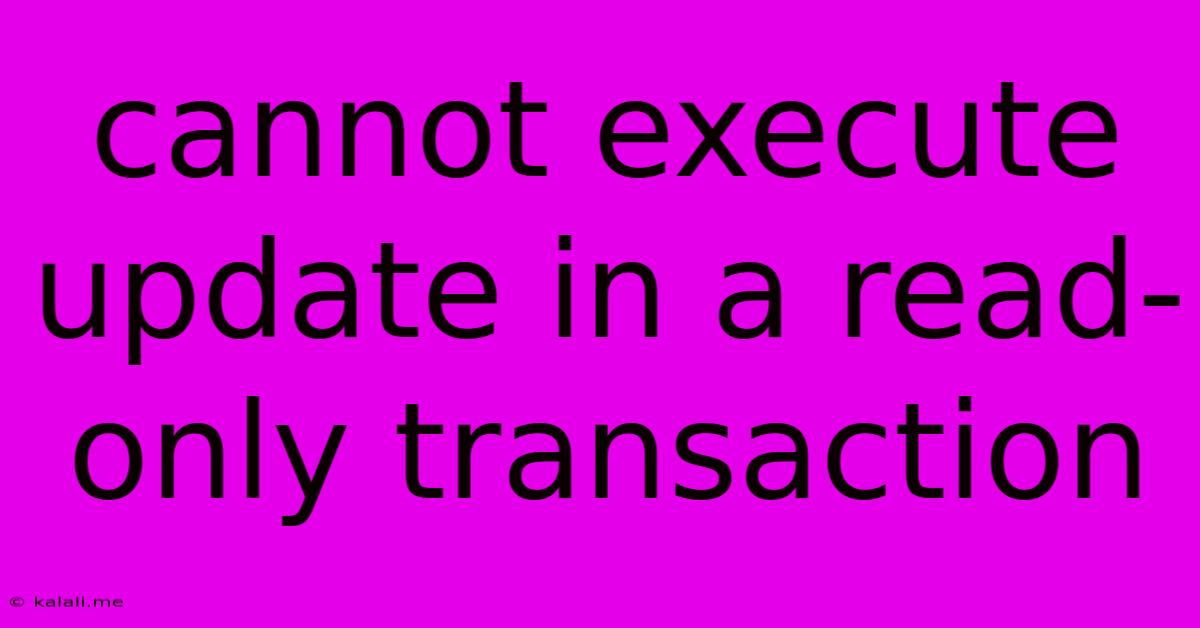Cannot Execute Update In A Read-only Transaction
Kalali
Jun 09, 2025 · 4 min read

Table of Contents
Cannot Execute UPDATE in a Read-Only Transaction: Understanding and Solving the Error
The error message "cannot execute UPDATE in a read-only transaction" is a common problem encountered when working with databases, particularly within the context of database transactions. This article will delve into the root cause of this error, explore various scenarios where it might arise, and offer practical solutions to resolve it. Understanding this issue is crucial for developers to build robust and reliable database applications.
This error essentially means you're attempting to modify data (using an UPDATE statement, or similar operations like INSERT or DELETE) within a database transaction that has been explicitly or implicitly set to read-only mode. Read-only transactions are designed to prevent accidental data modifications and ensure data consistency, especially in concurrent environments.
Understanding Database Transactions and Read-Only Mode
Database transactions are a sequence of database operations performed as a single logical unit of work. They guarantee atomicity (all operations succeed or all fail), consistency (data remains valid), isolation (transactions don't interfere with each other), and durability (changes persist even if the system crashes).
Read-only transactions are a specific type of transaction designed to only read data; they don't allow any modifications. This is often used for reporting, analytics, or situations where you only need to retrieve information without altering the database state. The benefits include improved concurrency and enhanced data protection.
Common Scenarios Leading to the Error
Several situations can trigger the "cannot execute UPDATE in a read-only transaction" error:
-
Explicitly Setting Read-Only: Your database connection or transaction might be explicitly configured as read-only. This is often done through connection string parameters or API calls specific to your database system (e.g., MySQL, PostgreSQL, SQL Server). Check your database configuration and connection settings.
-
Implicit Read-Only Transactions: Certain database systems or frameworks might implicitly create read-only transactions under specific circumstances. For example, a long-running query might unintentionally be treated as a read-only transaction by the database engine due to resource management or optimization strategies.
-
ORM Frameworks: Object-Relational Mappers (ORMs) like Hibernate (Java), SQLAlchemy (Python), or Entity Framework (C#) can sometimes inadvertently create read-only transactions if their configuration isn't properly managed. Inspect your ORM settings and transaction management code.
-
Nested Transactions: If your code involves nested transactions, and an outer transaction is set to read-only, the inner transactions will also inherit this read-only property. Carefully review your transaction nesting logic.
-
Database Triggers or Stored Procedures: A database trigger or stored procedure might be implicitly setting the transaction to read-only. Review the definition of any relevant triggers or stored procedures.
Resolving the "Cannot Execute UPDATE" Error
The solution depends on the root cause. Here are some troubleshooting steps:
-
Review Connection Settings: Carefully examine your database connection string or configuration parameters. Ensure that the read-only flag or attribute is not set.
-
Inspect Transaction Management Code: If you're using transactions explicitly, verify that you're not inadvertently setting the transaction to read-only. Ensure the correct transaction isolation level is used.
-
Check ORM Configuration: If employing an ORM, review its configuration files and transaction management settings. Ensure that read-only transactions aren't being inadvertently created.
-
Debug Transaction Behavior: Use debugging tools or logging to trace the flow of your transactions and identify when and where the read-only setting is applied.
-
Analyze Database Triggers and Stored Procedures: Thoroughly examine the code of any relevant database triggers or stored procedures that might be impacting transaction behavior.
-
Consider Transaction Isolation Levels: Adjusting the transaction isolation level might resolve conflicts in some cases, allowing updates to occur properly. However, carefully evaluate the implications for data consistency.
-
Refactor Your Code: If the read-only transaction is necessary for a specific part of your application, refactor your code to separate read-only operations from write operations into distinct transactions. This promotes better database design and avoids conflicts.
By systematically investigating these aspects, you should be able to identify the source of the error and implement the necessary corrections. Remember that maintaining proper transaction management is paramount for the stability and reliability of any database application.
Latest Posts
Latest Posts
-
How Many Minutes Are In 40 Hours
Jul 01, 2025
-
How Many Cups Are In 16 Oz Of Sour Cream
Jul 01, 2025
-
How Many Quarters Are In 20 Dollars
Jul 01, 2025
-
How Many 1 3 Cups Equal A Cup
Jul 01, 2025
-
How Many Hours Are In Two Years
Jul 01, 2025
Related Post
Thank you for visiting our website which covers about Cannot Execute Update In A Read-only Transaction . We hope the information provided has been useful to you. Feel free to contact us if you have any questions or need further assistance. See you next time and don't miss to bookmark.